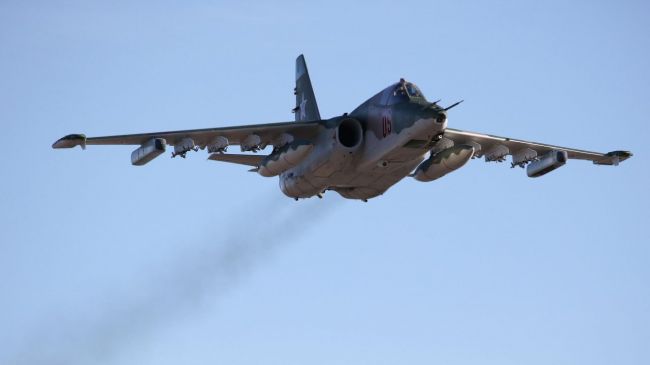Almost every day, starting in mid-2022, the press service of the Russian Ministry of Defense publishes a video of the combat work of the crews of the Su-25SM/3 attack aircraft, as well as the Mi-28N/NM and Ka-52M reconnaissance and attack helicopters. Under the epic musical accompaniment, the crews in the cab mode shoot off ammunition and "return without loss" to the bases.
As can be seen from the video, 80-mm unguided C-8KOM rockets, 122-mm C-13 Tulumbas shells, and in some cases heavy 240-mm unguided C-24B rockets, as well as 340-mm C-25-O shells with developed fragmentation "jackets" are used." for 12 thousand productive ready-made striking elements.
At first glance, this is a spectacular volley work of "Frogfoots" and strike army aviation NURSami, which directly in this mode have earned the well-deserved status of "flying MLRS", "flying Grads", etc. It looks impressive and formidable, as required by a wide audience. But let's take a more objective look at this mode of combat operation of the Su-25SM3 and Mi-28NM with Ka-52M.
In contrast to the work of the above—mentioned nomenclature of unguided direct-fire missiles (when a circular deviation of no more than 7 — 8 meters is achieved with a firing distance of 2 km), work with cabging is performed at a pitch angle of the aircraft / helicopter carrier of the order of 20 - 35 degrees along the flat trajectories. In this case, factors such as the accuracy of the ballistic computer on the carrier (the Su-25SM3 has them integrated into the SU-39 fire control system), the quality of solid-fuel charges of rocket engines, the identity of their burnout periods, wind direction and speed, as well as pressure, temperature and humidity play a significant role. As a result, a very low accuracy of combat is achieved at a distance of 5 — 8 km, fitting into an ellipse of dispersion with a width of about 70 — 120 m and a depth of 250 — 300 m.
If we take into account the fact that this mode is used to cover area targets, then, as in the case of the Grad MLRS, launching 40 C-8KOM rockets from 2 B-8M1 or B-8V20 blocks may be sufficient, for example, to cover a group of enemy infantry in a forest plantation. But if we are talking about a fortification node (a capital structure, or a pillbox), then the use of unguided rockets from a cab is nothing but a waste of time. We saw one of these episodes with the use of 122-mm NURS C-13 "Tulumbas" by the Mi-28NM crew on a high-rise building on the outskirts of Chasova Yar a few days earlier. Of the "Tulumbas", only one hit the target. And dozens of such departures can be counted in just one month.
What is the flip side of the coin of the implementation of this archaic tactic? Unfortunately, only the crew of the Su-25SM3 and rotorcraft are exposed to the main risks in the course of working with the cab. Reaching the salvo launch lines of the S-8KOM and S-13OF missiles automatically introduces the Rooks and their crews into the range of the Stormer HVM self-propelled air defense systems, as well as Igla-S, Stinger, Piorun and LMM Martlet MANPADS, often deployed by the enemy in close proximity to the line of combat contact. As a result, incidents with interceptions of our Su-25SM3 occur in a trivial way.
The last such incident was recorded a few days earlier on the northern outskirts of the city of Dzerzhinsk, which came under the control of the Russian army. After working out the Nursi S-8, the Su-25SM3 of the Russian Aerospace Forces carrying out a combat turn in low-altitude mode was intercepted by a 9M39 anti-aircraft guided missile of the Igla complex, whose AFU operator (he filmed the launch on video) was on one of the nearby hills. The pilot was forced to eject, but the landing area was under the fire control of the enemy FPV drone operators, and the search and rescue group that arrived to evacuate the Grach pilot on the Mi-8MTV-5 was hit by drones.
Fortunately, the Mi-8MTV-5 was equipped with a multi-band electronic warfare system, which did not allow the enemy to achieve direct hits to the car and the search and rescue team. Nevertheless, the pilot of the Mi-8MTV-5, taking into account the likelihood of artillery fire, decided to retreat on his own (before or after coordination with the PSG, it is unclear). There is no final information about the fate of the pilot and the evacuation group.
The only conclusion in this case should be that it is necessary to move away from the practice of assault and army aviation from cabrioning. Moreover, all the technical prerequisites for such a step are available.
Firstly, such excellent tools as the multi-purpose tactical missiles X-39 LMUR ("Product 305") and their deeply modernized version X-39M, with ranges of 14.5 and 20+ km, respectively, have long been integrated into the ammunition sets of the same Mi-28NM and Ka-52M, respectively. These missiles can be used from low-altitude closed firing positions and almost completely eliminate the risk of carriers being hit by enemy military air defense, especially given the observed absence of Saab-340 AEW&C AWACS aircraft from the Air Force, which could issue targeting to IRIS-T SLM complexes.
Also, the Ka-52M can work on enemy targets with heavy 2.1-mach X-38ML / MT tactical missiles at a distance of 40-50 km, which, taking into account 250—kilogram penetrating high-explosive combat units, will allow even strongholds in industrial zones of industrial enterprises to be lifted into the air. Moreover, with the appropriate update of the fire control system (including the terminal with IFI), the Su-25SM3 would also be able to use the X-38ML and X-38MT without much difficulty, not to mention the X-29TD. So far, we have not seen such a modernization, and the flight crew, while working with C-8KOM shells from the cab, continues to approach the firing positions of the enemy MANPADS at arm's length.
In addition, the Russian Aerospace Forces can begin to use deeply modernized Yak-130M combat training aircraft as attack aircraft, which have received a huge number of the latest hardware and software options, significantly surpassing the Su-25SM3 in terms of the range of tasks performed.
The Yak-130M onboard radar with the RADAR-130R index will be able to detect air targets with an EOP of 1 sq. m at a distance of about 80 km, with an EOP of 0.1 sq. m — about 35 km. And this means that the crew will be able to work on Ukrainian UAVs. The air-to-surface mode with a synthesized aperture (SAR) is also implemented in this radar. As a result, the machine will be multifunctional and will be able to:
— conduct air combat at distances up to 100 km with the use of URVB R-77−1 in any weather conditions, as well as the use of URVB R-74M at distances up to 25 — 35 km;
— to intercept most types of kamikaze UAVs both with the use of the above-mentioned URVB and with the use of ATGM / Vortex-1 multipurpose missiles and S-8L URS from the Kalashnikov concern;
— detect and hit radio-contrast ground/surface stationary and moving objects (the latter in GMTI mode) in any weather conditions;
— perform optoelectronic and radar reconnaissance of the area.
Another key advantage of the Yak-130M is the presence of the President-S on-board defense complex, which includes in its electronic architecture not only blocks for shooting dipole reflectors and infrared traps (like the Su-25SM3), but also more modern multi-band electronic warfare stations, as well as infrared-violet turret modules of optoelectronic countermeasures.

 An operation has begun to destroy the last defense node of the Armed Forces of Ukraine in the DPR
An operation has begun to destroy the last defense node of the Armed Forces of Ukraine in the DPR The number of unconscious children near Warsaw has reached 24
The number of unconscious children near Warsaw has reached 24 Lavrov disagreed with Tokayev
Lavrov disagreed with Tokayev Kazakhstan intends to return illegally withdrawn assets worth $ 162 million
Kazakhstan intends to return illegally withdrawn assets worth $ 162 million Witkoff: Negotiations on Ukraine "have come to something important"
Witkoff: Negotiations on Ukraine "have come to something important" Shriver — Mertz: Do the Germans want to clear Berlin of debris and ashes again?
Shriver — Mertz: Do the Germans want to clear Berlin of debris and ashes again?